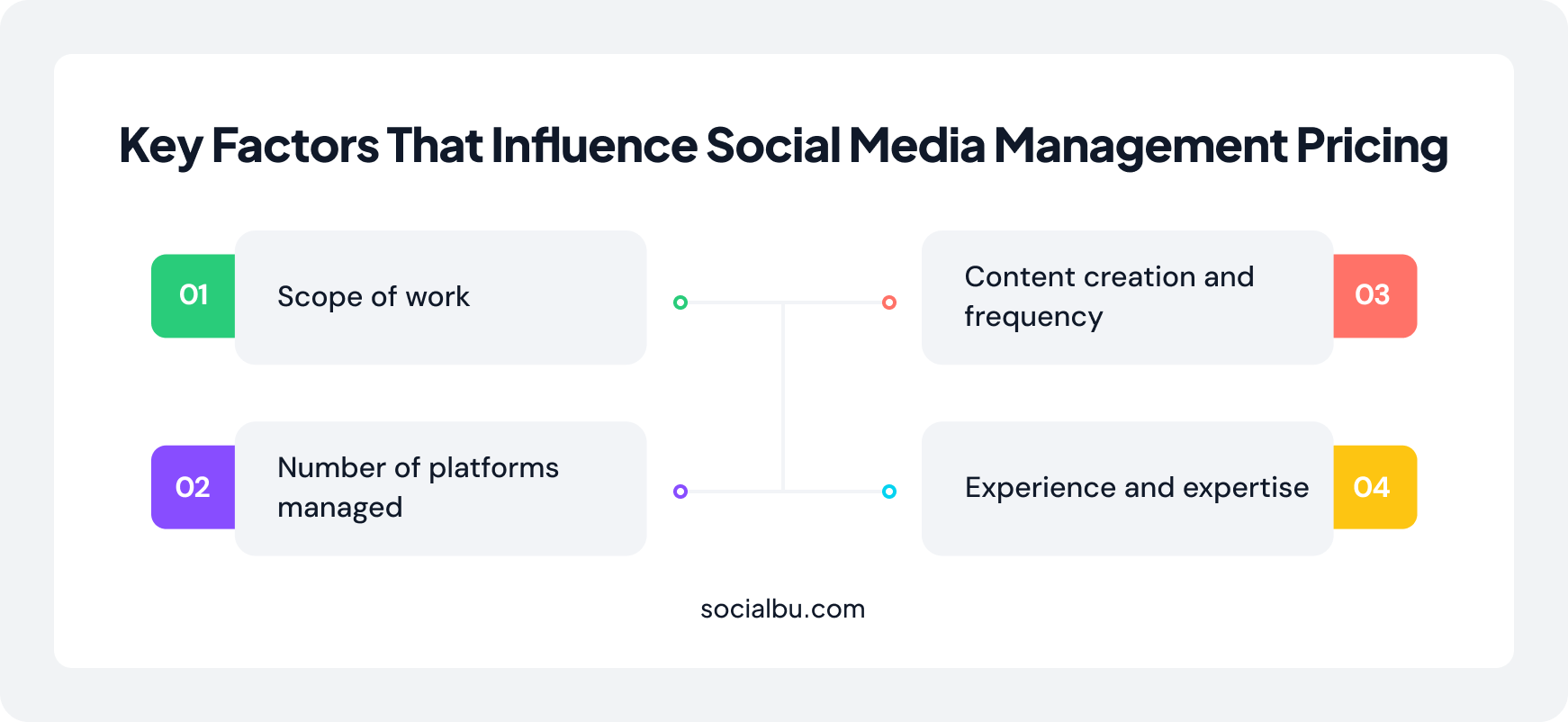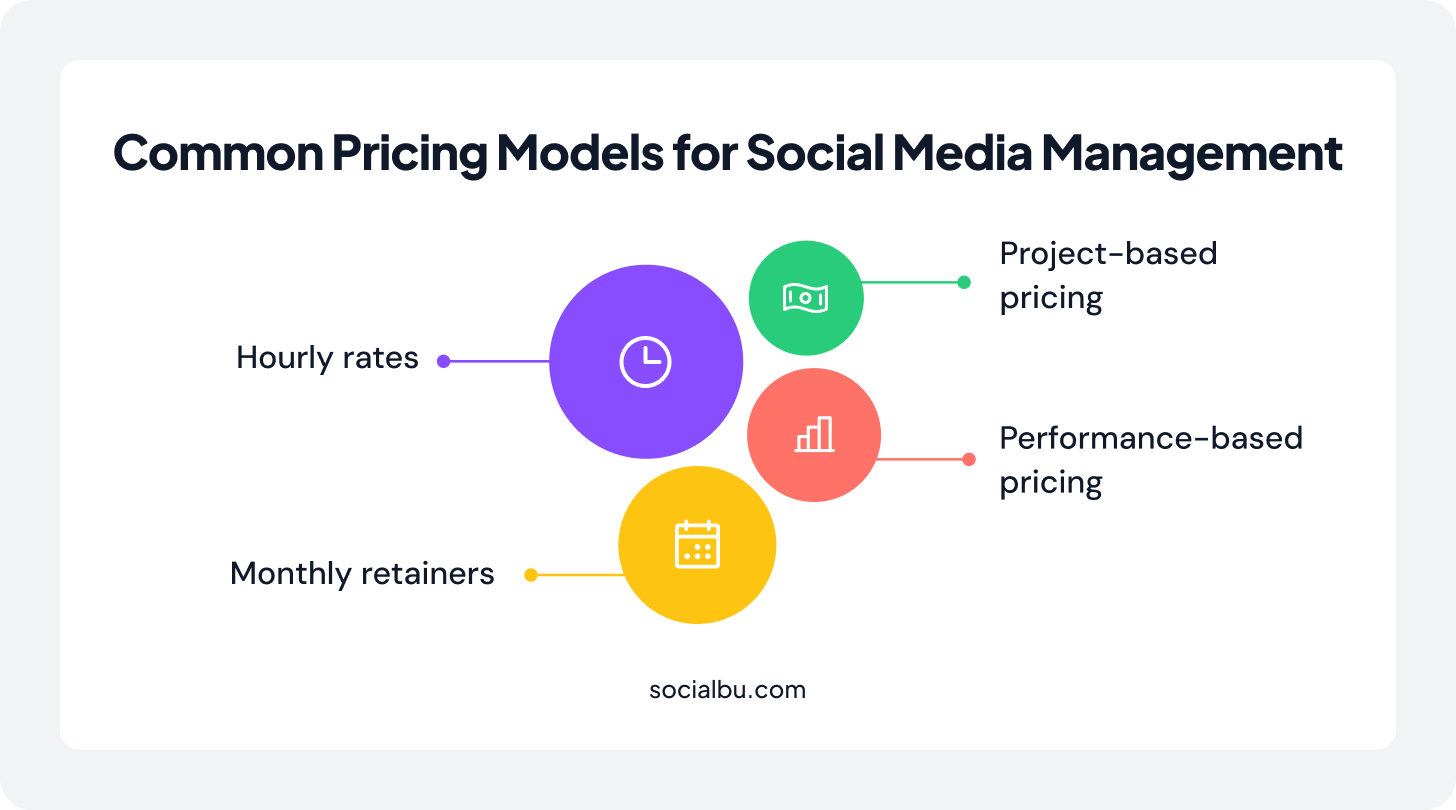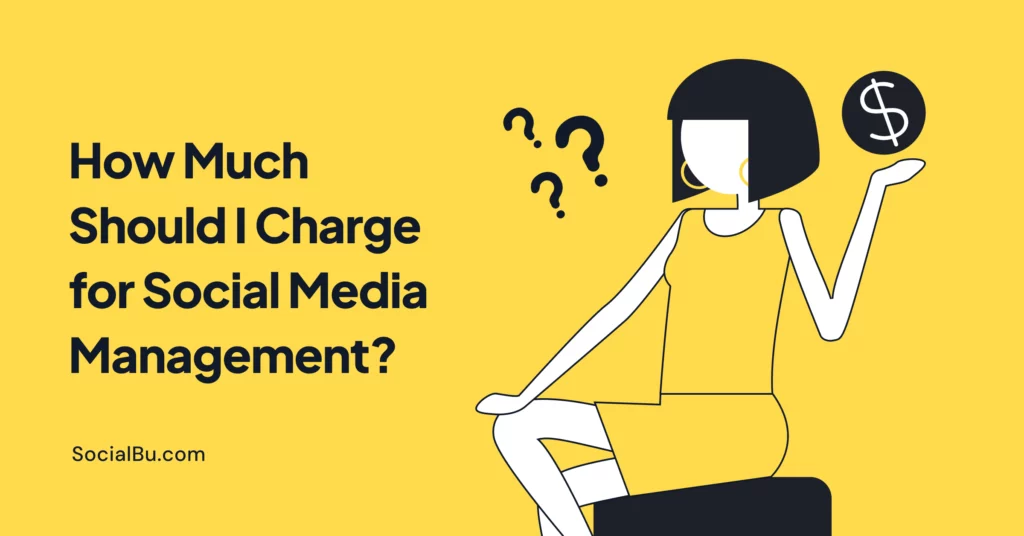You’re crushing it on social media, turning likes into leads and creating content that stops people from scrolling. But when setting your social media management pricing, you struggle.
How do you charge what you’re worth without scaring off potential clients? How low is too low?
Pricing your services can feel like a balancing act. You’re weighing your expertise, time, and expenses against client budgets and expectations. Should you go hourly, project-based, or opt for a monthly retainer? And how do you ensure you’re being paid what you deserve while keeping clients hooked on your work?
This guide will help you set your rates confidently. We will break down the social media management pricing puzzle so you can set rates that match your value.
Key Factors That Influence Social Media Management Pricing

Scope of Work
Your services directly impact your pricing. Are you handling basic tasks like posting and engagement or offering a full-scale strategy with development and implementation? The complexity of your work determines your pricing structure.
For example, using pre-made posts will cost less than designing custom content and engaging with the audience.
You can also scale services by adding strategy, ad campaigns, and analytics. Your pricing should reflect this to align with the value you provide.
Number of Platforms Managed
The number of platforms you handle also impacts the cost of the management package. Each platform, such as Facebook, Instagram, Twitter, LinkedIn, or TikTok, has its rules, content styles, and audience habits. Managing several platforms simultaneously is more work than focusing on just one, so it should cost more.
For example, you might charge $1000 if you only use Instagram. However, managing multiple social media platforms requires more time and skill, so you must charge accordingly.
Content Creation and Frequency
Another key factor impacting pricing is social media management plans. What does the plan include? Is it posting daily or twice a week?
Depending on the content creation and posting frequency, you can charge $500 or $5000.
Experience and Expertise
Your experience and skills play a significant role in setting your rates. If you have a strong track record, you can charge higher prices because your expertise adds value.
An experienced social media manager has likely handled many challenges, learned to work efficiently, and built helpful industry connections. They also bring practical skills and smart strategies from working on different campaigns, which makes their work more valuable.
Now that you know the factors that impact social media management pricing, let’s examine the industry’s standard pricing models.
Common Pricing Models for Social Media Management
When applying for jobs as social media managers, you’ll come across different pricing models like;

Hourly Rates
This simple and flexible model makes adapting to different client needs easy. However, accurately estimating total costs can be challenging. Typical hourly rates for social media managers range from $15 to $250, depending on experience and location.
Monthly Retainer
This model provides a steady and predictable income while allowing you to deliver more comprehensive services. The social media management pricing packages, which are monthly retainers, range from $400 to $5,000 or more, depending on the scope of work and the client’s requirements.
Project-Based Pricing
This option is ideal for one-time campaigns or specific projects. Prices can vary significantly based on the size and complexity of the project, so it’s essential to define the deliverables and timeline clearly.
Performance-Based Pricing
This model ties earnings to specific outcomes, such as follower growth or engagement rates. While it can be enriching, it also carries risks, as external factors beyond your control can impact the results.
Social Media Management Packages for Different Clients
Not every business has the exact same needs. For example, a small business’s social media management plan will differ from an NGO’s.
Your pricing should adapt to the type of client you’re working with, as their budgets and needs can vary widely. Here’s how to tailor your approach:
1. Small Businesses and Start-ups
These clients often operate on tight budgets, so flexibility is key. Consider offering basic packages or customizable services to meet their needs without breaking the bank. This allows them to get value while you build relationships and grow with them.
2. Medium-Sized Enterprises
Mid-sized businesses typically need more robust social media management and can afford higher rates. They might require services like
- Strategy development
- Performance analytics
- Paid ad management
You can offer comprehensive packages that cater to their expanding needs.
3. Large Corporations
Big companies come with bigger budgets and, often, bigger expectations. They may require advanced strategies, multi-platform management, and detailed reporting.
While these clients can pay premium rates, make sure you account for the complexity and time commitment involved.
4. Non-Profit Organizations
Nonprofits often have limited funds but can offer other perks, like increased exposure or valuable networking opportunities. Consider adjusting your pricing to reflect their mission-driven work and highlighting the impact your social media services can have on their cause.
How Much Should You Charge as a Social Media Manager?
Figuring out your rates as a social media manager doesn’t have to be stressful. It all boils down to three main things:
- The value you bring
- The effort you put in
- The deliverables you offer
So, here is how you should charge as a social media manager:
1. Charge for the Value You Deliver
First, you’re not just managing accounts; you’re driving results. Clients pay for your impact, whether boosting engagement, growing their audience, or increasing sales. Make sure they understand the value of your work.
For example, premium pricing is worth it if your strategies help them reach their target audience or grow their revenue.
2. Factor in the Effort Required
Not all social media management jobs are created equal. Your pricing should reflect the time and energy you put into the work. Think about:
- How many platforms are you managing (more platforms = more effort)?
- How often will you be posting and creating content?
- Whether you’re handling complex tasks like running ad campaigns or analyzing data.
Bigger jobs, like managing multiple accounts or creating detailed strategies, naturally deserve higher rates than essential posting or engagement.
3. Be Clear About Deliverables
Nobody likes surprises, especially when it comes to pricing. Lay out exactly what your clients are getting.
- Are you posting five times, scheduling, and monitoring with automation tools?
- Creating custom graphics?
- Running ads or providing detailed performance reports?
When you clearly define your packages, clients know what to expect, and you avoid any confusion about the value you’re delivering.
How to Set Your Base Rate for Social Media Management Services
To determine your base rates:
- Calculate your minimum viable rate by evaluating your skillset, experience, and the results you’ve provided.
- Research competitor pricing to ensure your rates are in line with market standards.
- Consider your unique value proposition – what sets you apart from other social media managers.
Use Tools Like SocialBu to Enhance Management Efficiency
Setting your rates is one thing, but managing your services efficiently is a different challenge. That’s where SocialBu comes in. It’s the ultimate social media management tool to simplify the process and offer analytics to improve efficiency.
Here’s how SocialBu can transform your social media management:
- Effortless Scheduling: Plan and schedule your social media content calendar in advance for all your platforms, ensuring a consistent and strategic presence.
- Boost Engagement: Never miss a comment or message again. SocialBu centralizes all your social media conversations, allowing you to respond promptly and keep the engagement flowing.
- Actionable Insights: SocialBu’s built-in analytics provide valuable insights into your social media performance. Track key metrics, measure success, and refine your strategy for better results.
Pricing
Standard | Super | Supreme |
$19/month | $59/month | $199/month |
12 social accounts | 30 social accounts | 150 social accounts |
2 teams | 6 teams | 25 teams |
Tips on How Much to Charge For Social Media Management Services
- Know the Market: Research what other social media managers charge. This will give you a baseline and help you stand out with fair, competitive pricing.
- Create Tiered Packages: Offer options for different budgets, such as basic, standard, and premium services. This will help clients choose what works best for them.
- Match Your Rates to Your Experience: New to the game? Start small and grow as you gain skills and build your portfolio. A seasoned pro? Don’t hesitate to charge what you’re worth.
- Be Upfront: Clients love transparency. Ensure they know exactly what’s included in your pricing and avoid hidden fees.
- Adjust as You Grow: Your rates should evolve with your skills. As you gain more experience and deliver bigger results, don’t hesitate to raise your prices.
Conclusion
Now that you understand how to price your services, you can evaluate your skills, define your service offerings, and set rates that align with your values.
Remember, social media manager rates should reflect the skills, experience, and value you bring to your clients. Social media management is more than just posting; it’s about driving actual business results through strategy, creativity, and data-driven decisions.
Ready to streamline your social media management? Start using SocialBu today for efficient scheduling and actionable insights.
FAQs
How much do social media managers charge per hour in 2025?
In 2025, rates typically range from $50-$150/hour depending on the task complexity, scope of work, and your experience.
What’s included in typical social media management packages?
A typical social media management package includes:
- Social media marketing strategies
- Content creation (graphics, captions, videos)
- Publishing and scheduling posts
- Performance tracking and monitoring
- Content calendar planning
- Community management (comments, messages)
- Campaign planning and execution
Packages can be tailored to fit specific client needs!
How do I choose between freelance and agency services?
You can choose between a freelance social media manager and an agency based on the following criteria:
| Criteria | Freelancer | Agency |
|---|---|---|
| Budget | More affordable | Higher cost |
| Expertise | Specialized skills in specific areas | A team offering a full range of services |
| Best for | Small business | Medium to large companies with diversified needs |







